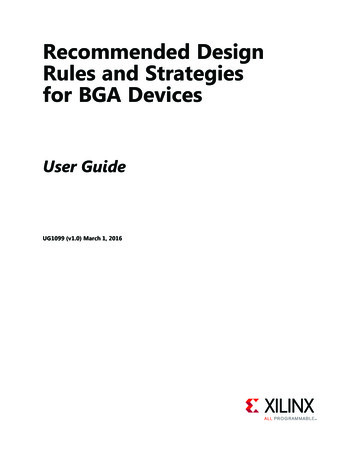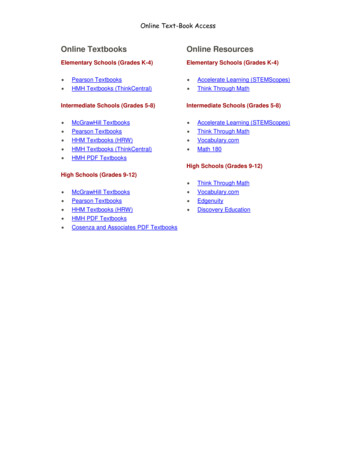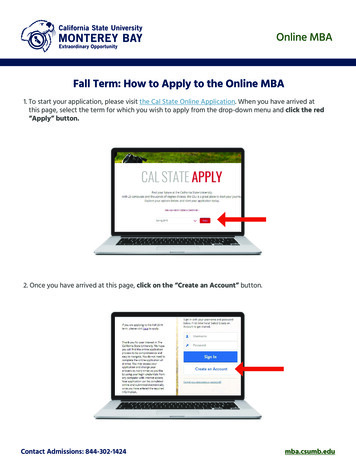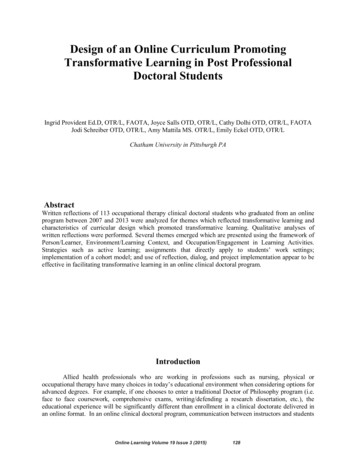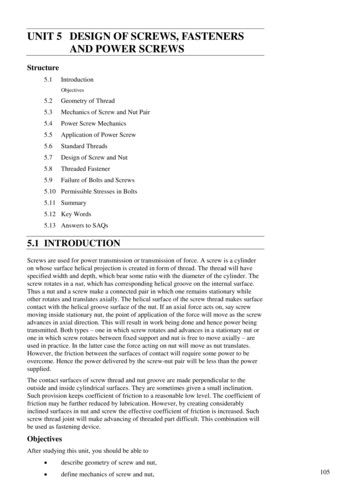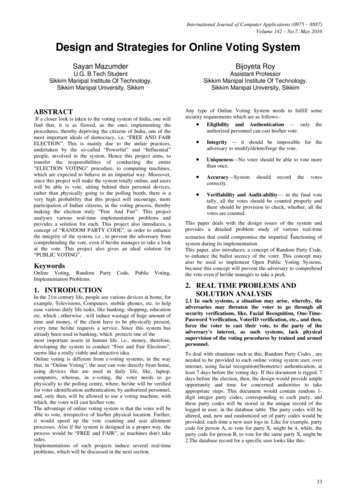
Transcription
International Journal of Computer Applications (0975 – 8887)Volume 142 – No.7, May 2016Design and Strategies for Online Voting SystemSayan MazumderBijoyeta RoyU.G. B.Tech StudentSikkim Manipal Institute Of Technology,Sikkim Manipal University, SikkimAssistant ProfessorSikkim Manipal Institute Of Technology,Sikkim Manipal University, SikkimABSTRACTIf a closer look is taken to the voting system of India, one willfind that, it is as flawed, as the ones implementing theprocedures, thereby depriving the citizens of India, one of themost important ideals of democracy, i.e, ―FREE AND FAIRELECTION‖. This is mainly due to the unfair practices,undertaken by the so-called ―Powerful‖ and ―Influential‖people, involved in the system. Hence this project aims, totransfer the responsibilities of conducting the entire―ELECTION VOTING‖ procedure, to computing machines,which are expected to behave in an impartial way. Moreover,since this project will make the system totally online, and userswill be able to vote, sitting behind their personal devices,rather than physically going to the polling booth, there is avery high probability that this project will encourage, moreparticipation of Indian citizens, in the voting process, therebymaking the election truly ―Free And Fair‖. This projectanalyses various real-time implementation problems andprovides a solution for each. This project also introduces, aconcept of ―RANDOM PARTY CODE‖, in order to enhancethe integrity of the system, i.e , to prevent the adversary fromcomprehending the vote, even if he/she manages to take a lookat the vote. This project also gives an ideal solution for―PUBLIC VOTING‖.KeywordsOnline Voting, RandomImplementation Problems.PartyCode,PublicVoting,1. INTRODUCTIONIn the 21st century life, people use various devices at home, forexample, Televisions, Computers, mobile phones, etc. to helpease various daily life tasks, like banking, shopping, educationetc. which , otherwise , will induce wastage of huge amount oftime and money, if the client have to be physically present,every time he/she requests a service. Since this system hasalready been used in banking, which protects one of themost important assets in human life, i.e., money, therefore,developing the system to conduct ―Free and Fair Elections‖,seems like a really viable and attractive idea.Online voting is different from e-voting systems, in the waythat, in ―Online Voting‖, the user can vote directly from home,using devices that are used in daily life, like, laptop,computers, whereas, in e-voting, the voter needs to gophysically to the polling centre, where, he/she will be verifiedfor voter identification authentication, by authorized personnel,and, only then, will be allowed to use a voting machine, withwhich, the voter will cast his/her vote.The advantage of online voting system is that the voter will beable to vote, irrespective of his/her physical location. Further,it would speed up the vote counting and seat allotmentprocesses. Also if the system is designed in a proper way, theprocess would be ―FREE and FAIR‖, as machines don't takesides.Implementations of such projects induce several real-timeproblems, which will be discussed in the next section.Any type of Online Voting System needs to fulfill somesecurity requirements which are as follows: Eligibility and Authentication — only theauthorized personnel can cast his/her vote. Integrity — it should be impossible for theadversary to modify/delete/forge the vote.Uniqueness—No voter should be able to vote morethan esVerifiability and Audit-ability— in the final votetally, all the votes should be counted properly andthere should be provision to check, whether, all thevotes are counted.This paper deals with the design issues of the system andprovides a detailed problem study of various real-timescenarios that could compromise the impartial functioning ofsystem during its implementation.This paper, also introduces, a concept of Random Party Code,to enhance the ballot secrecy of the voter. This concept mayalso be used to implement Open Public Voting Systems,because this concept will prevent the adversary to comprehendthe vote even if he/she manages to take a peek.2. REAL TIME PROBLEMS ANDSOLUTION ANALYSIS2.1 In such systems, a situation may arise, whereby, theadversaries may threaten the voter to go through allsecurity verifications, like, Facial Recognition, One-TimePassword Verification, VoterID verification, etc., and then,force the voter to cast their vote, to the party of theadversary’s interest, as such systems, lack physicalsupervision of the voting procedures by trained and armedpersonnel.To deal with situations such as this, Random Party Codes , areneeded to be provided to each online voting system user, overinternet, using facial recognition(biometric) authentication, atleast 7 days before the voting day. If this document is rigged, 7days before the election, then, the design would provide ampleopportunity and time for concerned authorities to takeappropriate steps. This document would contain random 1digit integer party codes, corresponding to each party, andthese party codes will be stored in the unique record of thelogged in user, in the database table. The party codes will bealtered, and, new and randomized set of party codes would beprovided, each time a new user logs in. Like for example, partycode for person A, to vote for party X, might be 4, while, theparty code for person B, to vote for the same party X, might be2.The database record for a specific user looks like this:33
International Journal of Computer Applications (0975 – 8887)Volume 142 – No.7, May 2016Table1. Unique record for a userThese codes will be used by the user, to cast his/her vote.The entered code would be compared against the party name,that corresponds to the code, in the unique record of the voter,in the database table.Then, the vote count, for the retrieved party name isincremented, in the results table.Since 7 days before the election, the user usually knows, whichparty he’s going to vote for, and remembering a 1-digit integeris no big deal, the user will be allowed to view this documentonly once, and has to remember or note down the 1-digitinteger code, for voting purpose, after 7 days, for securityreasons.If a situation arises, where the codes are lost/forgotten, the userwill be issued a new set of party codes, but only at the physicalelection office, before the voting day.Hence, when an adversary, forces a voter, to go through withbiometric, voterID, password and other authenticationprocedures and then, threatens the user to cast his/her vote, tothe party of the adversary’s choice, the concept of ―RandomParty Codes‖ will not allow the adversary to comprehend, towhom the user is voting, since the codes are given in a randomorder, and the code sets are different for different users, takingaway the ability of the adversary to evaluate the vote, even ifhe manages to take a look at it.Hence, there would be a scope for the user, to vote for theparty, according to his/her own autonomous choice, despitebeing threatened, after all verifications are successfullycompleted.2.2 There might be a situation where, the biometric orfacial recognition might be faked, whereby, the adversarymay try to fake the facial recognition procedure, using astill image, or facial masks of the authorized voter, thuscompromising the whole design.Such problems can be solved using the concept -—imageproperties, of a real time facial object in the environment,produced by the webcam, which always differs from the imageproperties of a facial object, taken from a still photo, using thesame device[2].The project ―Face Spoof Detection with Image DistortionAnalysis‖, as cited, which is implemented over ImageDistortion Algorithm (IDA) using features like speculareflection, blurriness, chromatic moment, color diversity, etc.can be used to solve this problem.2.3 Another situation may be considered, where theinability of the adversaries to penetrate the system, mightdrive them, to tamper various objects of interest to thesystem, in publicly accessible areas, like the streets. Forexample, if the system is designed over SocketProgramming and Networking, the adversaries mighttamper street cables, routers, etc. thereby disrupting thewhole voting procedure.Satellite Communication is the ideal solution to this problem,as it reduces the number of objects of interest to the systemthat requires protection, although the communication system isnot very reliable. To overcome the reliability factor, eachapplication might be given, a time period of 5 days for use, asthe communication system is expected to work, at least for afew hours, within that time frame.Since the system is sound enough, to support ―public voting‖,i.e, voting in front of other people, due to the concept ofRandom Party Code, the system would function at its best, ifthe applications are built into TV Set-Top-Box applications. Asmaximum homes, these days, has at-least one TV, the devicecan be used as a voting machine, by an entire family, to gothrough with the voting procedures, thereby, reducing cost.3. SYSTEM FRAMEWORK DESIGNThe design of the system will include a registrationapplication, whose servers would be open throughout the year,and would be closed only 15 days before the voting day.This application would be used by eligible citizens of India, toregister for ―Online Voting‖ who are interested to vote online.A facial record would be generated by this application andwould also register the user’s unique voter identificationauthentication records along with a personal mobile number ofthe user, in the user’s unique record in the registrationdatabase. The registered face, and its corresponding votingrequisites would be verified with the real Election commissiondatabase, to ensure that, only authenticated and verified,personalities are allowed to vote, i.e, the voter is anauthenticated and eligible citizen of India.The second application would be used to generate, store anddeploy the random party codes, to the already registeredvoters, after proper biometric (facial) verification, with thebiometric record of the corresponding user, which shouldalready be present in the registration database, provided theuser is an authentic one. The servers for this application wouldbe closed 7 days before the election and the users will beallowed to use this application only once, to view their uniqueset of random party codes, which they would have toremember or note down, and then, keep it safe for 7 days.Since the majority of the voters already know which party theyare going to vote for, 7 days before the election, and therandom party codes are only 1-digit random integers,remembering a single integer for 7 days, should not be aproblem. Still, if the codes are lost by an user, new codes forthat user can be generated, but only at the physical electionoffice.Now, if this document is tried to be rigged, 7 days before thevoting day, the situation should provide ample time andinformation about the parties which are availing unfair means,so that proper and stern steps can be taken, by the concernedauthorities.The third application will be used for voting. The servers forthis application would be opened only on voting days and eachuser would be able to use this application, just once.This application will first perform a biometrical verification ofthe user, using the biometric record of the user in the database,and his/her log-in username and password. Then, theapplication would proceed to verify the user’s voteridentification authentication records (for eg, Aandhar CardNumber, etc.).Upon successful verification, a One TimePassword would be generated and sent to the registered mobilenumber of the user, since 2 users with same biometrics anddevice number are impossible to find. The application wouldaccept and verify the OTP. Upon successful verification, theuser will be allowed to enter the voting mechanism, wherehe/she will enter his/her coded vote. The code entered by theuser will be matched, to retrieve the party name, with which,the code corresponds to, in the user’s unique record, in thedatabase table. Then, the count for the retrieved party name, isincremented in the results table.34
International Journal of Computer Applications (0975 – 8887)Volume 142 – No.7, May 2016The user then receives a ―vote registered" authenticationmessage, and then, the servers are blocked for that user, usinga boolean variable, so that he/she cannot enter for the secondtime.4. PROGRAM FLOW4.1 Registration Application FlowSTARTCAPTUREFACIAL IMAGEFROM CLIENTTERMINALAND SEND TOSERVERSAVE IMAGEIN SERVERDATABASE.ACCEPTUSERNAME,PASSWORDAND OTHERVOTEAUTHENTICATON RECORDS.ACCEPT AMOBILENUMBER FROMCLIENT FOROTPMECHANISM.1TALLY FACIAL ANDOTHER RECORDS WITHELECTION COMMISSIONDATABASE FORAUTHENTICITY.ON PROPERAUTHENTICATION,GENERATE RANDOMPARTY CODES FOREACH PARTY, FORTHAT SPECIFICUSER.STORE USERNAME,PASSWORD ANDOTHER VOTINGAUTHENTICATIONRECORDS ALONGWITH RANDOMPARTY CODES INTHE RECORD FORTHAT USERISSUE UNIQUE PIDINTEGER AND SENDUSER REGISTRATIONACKNOWLEDGEMENTSTOP1Fig1. User Registration Flowchart35
International Journal of Computer Applications (0975 – 8887)Volume 142 – No.7, May 20164.2 Party Code Release Flow2CAPTURE FACIALIMAGE FROM CLIENTTERMINAL AND SENDTO SERVERACCEPT USERNAME,PASSWORD ANDOTHER VOTEAUTHENTICAT-ONRECORDS.USE THENEWLYCAPTUREDIMAGE ANDPID, ISSUEDDURINGREGISTRATIONTO COMPAREWITH FACIALRECORDSSTORED INSERVERDATABASEON PROPERAUTHENTICATION, PULL THERANDOMPARTY CODESOF EACHPARTY FORTHAT SPECIFICUSER, FROMHIS/HERDATABASERECORD ANDSEND TO USERTERMINAL4.3 Voting FlowSTART33CAPTURE FACIALIMAGE FROMCLIENT TERMINALAND SEND TOSERVERACCEPTUSERNAME,PASSWORDAND OTHERVOTEAUTHENTICATON RECORDS.USE THENEWLYCAPTUREDIMAGE ANDPID, ISSUEDDURINGREGISTRATIONTO COMPAREWITH FACIALRECORDSSTORED INSERVERDATABASEON BIOMETRICAND OTHERRECORDAUTHENTICATION,GENERATE AND
that corresponds to the code, in the unique record of the voter, in the database table. Then, the vote count, for the retrieved party name is incremented, in the results table. Since 7 days before the election, the user usually knows, which party he’s going to vote for, and remembering a 1-digit integer is no big deal, the user will be allowed to view this document only once, and has to .



